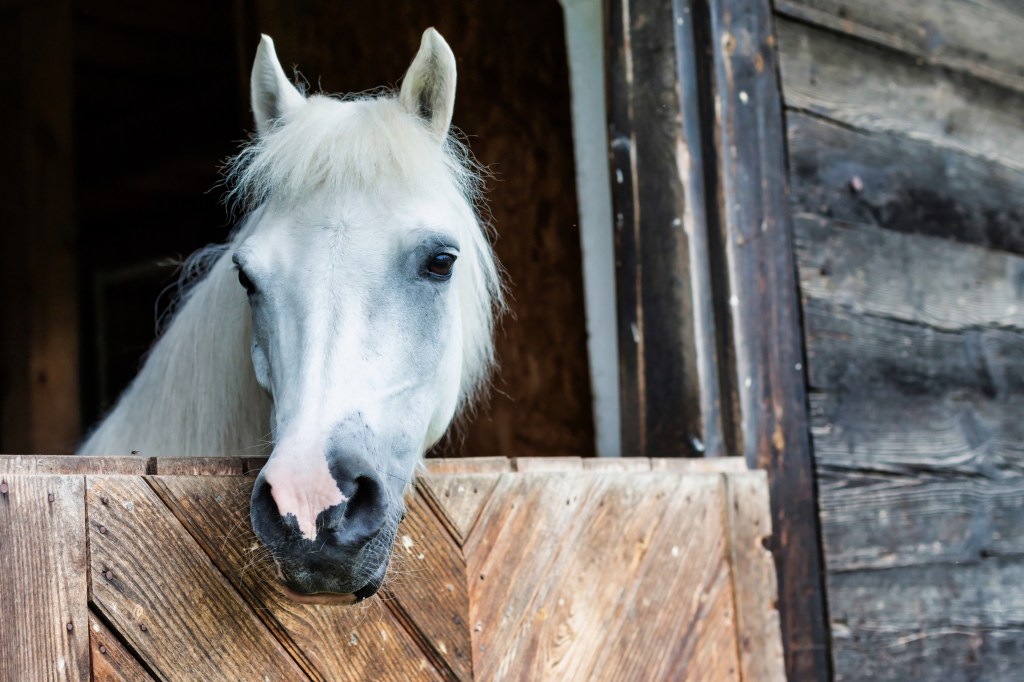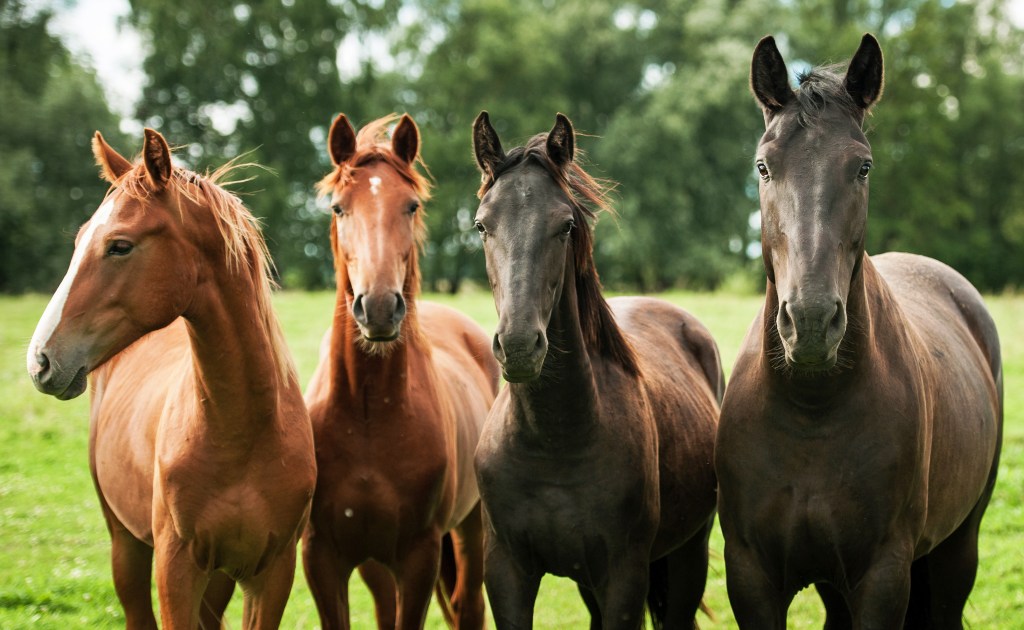ADVERTISEMENT FEATURE
Bringing a new horse home is an exciting time, but it can also be stressful. Even the calmest of horses may be unsettled when they move to a new home, but there are things you can do to help the transition go as smoothly as possible and with the least amount of distress experienced by your new equine companion. Knowing how to introduce a new herd member is an important part of understanding how to take care of a horse, so read on to feel as confident as possible during this exciting time.
For the past three years, I have run an equine foster yard for the Blue Cross, caring for horses before they go to their forever homes. I’m about to welcome my eighth foster horse into my yard, so I’ve had a fair bit of experience of settling horses into their new homes. Sadly, many of the horses I foster have been mistreated in some way, which means they need a bit more support to help them adjust and recover when they come to live with me. With this experience in mind, here are my top tips for settling a new horse into your yard.
Be prepared
Good organisation is key. If you plan to stable your horse, make sure you have a nice clean, bedded-down stable ready before they arrive. If they will be living out in the field, make sure it’s securely fenced and has constant access to clean, fresh water. It’s a good idea to consider having horse insurance in place, and make sure you have appropriate hard feed and forage such as hay ready to go.
It’s useful to find out from the horse’s former owner what feed and forage they have been eating. Also ask about their current routine, so that you can mirror it as far as possible (being stabled at night, for example). This will help your horse settle, as the routine will be familiar to them.
I also suggest that you have a headcollar and lead rope ready, plus a clean grooming kit to avoid cross contamination between horses, a first aid kit just in case of any bumps and scrapes on the journey, as well as appropriate rugs for the time of year.
Bringing a horse home
However calm or healthy your horse is, there are certain risks associated with transporting a horse. Consider what gear you will need to have to travel your new horse home safely. Kit includes:
- Travel boots to protect their legs in transport. Again find out what the horse’s previous history is with wearing these. If they don’t like them or have never worn them before, you’ll need to weigh up the pros and cons of using travel boots versus not. The same applies for a tail bandage or guard.
- A haynet
- Water to offer during breaks on long journeys and in case you breakdown.
- Hard hat (for you!)
- Gloves
- Lunge line
- Appropriate footwear
You need to load your horse in a safe and relaxed manner, preferably in the daylight. Plan your route home and remember to leave plenty of time, as you’ll need to drive carefully with a horse on board. It’s also a good idea to avoid the roads when they’re congested so time your journey outside of rush hour. It’s much less stressful for both you and your horse if you travel when the roads are quiet so that you’re unlikely to be held up in a traffic jam.
Quarantine for new horses

You’ll need to quarantine a new horse to make sure they are free from contagious diseases and illnesses before they interact with other horses on the yard. This means putting them in an isolated stable or a separate field where they can’t touch other horses. Remember horses are herd animals, so most will prefer being able to see and hear other horses, even if they can’t get close.
Infectious diseases to be aware of include strangles and equine flu. Some livery yards require you to test for strangles straight away, but the general advice is to quarantine new horses for the first 14 days. Many skin conditions are also transferable, so this time frame is generally considered long enough to give your new horse a fit bill of health.
Worm control is also vital. Before introducing a new horse to the herd you should have a faecal egg worm count carried out. Your vet will then advise whether you need to administer any wormer or not. Don’t let a new horse share a field until they are given the all clear for worms.
Finally, I suggest checking the horse over for any injuries they might have picked up on the journey home. Give them a general all-over health check when they arrive, including taking their weight and checking their temperature etc. Regular health checks are a good idea as they help you gauge what your horse’s ‘normal’ is, so that you spot any problems early.
Introducing a new horse to the herd
An unfamiliar environment can be unsettling for even the most relaxed horse, so a calm environment is vital. I advise doing the following:
- Introduce them to their new home slowly and then leave them to settle.
- Put them next to a ‘friend’ in the stable. Letting them develop a bond with an established member of the herd could help them be accepted.
- When their quarantine period is complete, put the horse in a secure paddock where they can see and touch the other horses and start to build relationships.
- Slowly introduce them to the rest of the herd, one horse at a time. Then observe how they interact and step in if needed. I would suggest adding one horse to your horse’s field and letting them bond, rather than putting your horse straight into a field with the whole herd.
Feeding and dietary changes
One of the golden rules of feeding a horse is making any changes to their diet. Finding out what they were eating at their previous home is a big part of being able to do this. Avoid changing their feed unless you really have to. If you do need to change it, do it slowly and preferably with veterinary advice. Keep an eye on their water intake too. The stress of changing environments, as well as having different grass and forage, could all increase the risk of digestive upset, including colic and gastric ulcers.
Vets, farriers and dentists

You will need to know when the horse’s hooves were last seen by a farrier and, if shod, when they are due for a new set of shoes. Also find out when their teeth were last checked by a vet or equine dental technician, and when they saw a physio. Their passport will tell you when your horse had their vaccination, so you can mark in your diary when they are due for a booster.
Other things you should do are:
- Register your horse with a vet straight away
- Register with a farrier. Doing so sooner rather than later may help avoid a long wait for a call out in the case of lameness or a lost shoe etc
- If you don’t have their previous dental records, have a dentist check their teeth as soon as possible, especially if you’re planning on riding the horse.
Getting ready to ride
I don’t think there is a set timeframe on when you should start riding a new horse. Some people say leave them for a couple of days, while others say wait a few weeks. The most important thing is to make sure the horse is settled before you ride them. Of course, some horses settle better with regular work. This is part of getting to know your horse.
Ideally, aim to have had the following visits before you begin riding so that you know they have been given a clean bill of health:
- Farrier to check their feet.
- Saddle fitter to ensure their tack fits well and/or to help you buy a new saddle.
- Physio to check their back.
- Vet (or equine dental technician) to check teeth and generally check your horse is sound and in good condition.
Top tips when buying a new horse
Whether you loan, rehome or buy, getting a new horse is a big deal. It takes a lot of time, money and emotional strength to get to the end result, so set yourself up for success by doing the following key things:
- Consider getting the horse vetted before you buy it. It isn’t a case of pass or fail, rather an opportunity for a vet to assess whether a horse is physically up to doing the job you require. They will also be able to highlight any underlying issues or problems that may need managing to help keep your horse healthy and happy.
- Get as much info from the previous owner as possible. Find out exactly where they are with their education, what they’re like to manage on the ground, load into a horsebox, ride or turnout with other horses etc. You could ask to speak to other people who know the horse too.
- Check their body condition score to make sure they’re not overweight or underweight.
- Find out what kind of herd they’re used to living in. Do they like being on their own? Are they used to being with another horse? Or with a herd? If the latter, do they live better with mares, geldings or a mix? Are they dominant in a herd which could cause confrontation and fighting, possibly leading to kicking and injuries, or are they shy and at risk of being bullied by other horses?
If you have any concerns about your horse’s wellbeing, contact your vet for advice.
Consider horse insurance
 From the moment you part with your cash and receive a receipt, you are responsible for your horse’s upkeep — and having an insurance policy in place can help to ease the strain of a large vet bill or offer piece of mind that you’re protected while hacking in public areas.
From the moment you part with your cash and receive a receipt, you are responsible for your horse’s upkeep — and having an insurance policy in place can help to ease the strain of a large vet bill or offer piece of mind that you’re protected while hacking in public areas.
Here at The Insurance Emporium, our products reflect our passions. We understand the things that matter to you. Give us call and get a free, no-strings quote today.
All content provided on this blog is for informational purposes only. The Insurance Emporium makes no representations as to the accuracy or completeness of any information on this site or found by following any link on this site. We will not be liable for any errors or omissions in this information nor for the availability of this information. We will not be liable for any loss, injury, or damage arising from the display or use of this information. This policy is subject to change at any time.
The Insurance Emporium offers a variety of cover levels, so please check the policy cover suits your needs before purchasing. For your protection, please ensure you read the Insurance Product Information Document (IPID) and policy wording, for information on policy exclusions and limitations.
Images: copyright Shutterstock









